The Architecture of Memory

Memory is the Key to Brain Power
Understanding the architecture of memory is the key to increasing brain power in a safe, natural and permanent way.
Your memory contains all of the information you have acquired throughout your entire life.
This information is directly related to the quantity of brain power you have for each area of your life.
A new model for memory
This page is the culmination of 28 years of research, you won’t find the following information anywhere else in the world.
On this page, you will learn a new model that explains the software for how memory is managed by your brain.
Once you finish this page, you are going to understand memory, mental health and your life on a whole new level.
What are Data Networks?
A data network is a powerful organization system your brain uses to manage all the of the data you have acquired.
Your brain has created millions of unique data networks throughout your life.
Data networks are like folders that store all the relevant information associated with one thing.
Your brain will create a unique data network to store information for each thing (noun) or for each action (verb).
Nouns & Verbs
Your brain will create a unique data network for every person you have met throughout your life.
You also have a unique data network for your home, vehicle, and each pet.
Every object you have ever interacted with has a unique data network stored in your memory.
Your brain will create unique data networks for every action you take, such as walking, showering, and driving a vehicle.
A data network is created for each job you have held, as well as additional data networks for all of the individual tasks you were required to do at your job.
Bits of Memory
The purpose of a data network is to create and organize bits of data that make up your memory.
A bit is defined as the standard unit of memory, used by your brain to store your information.
Each individual bit stores information, as well as the energy to use the information.
The energy within a bit, is Brain Power.
The health of a data network
Brain power determines the health and functionality of each data network.
We can classify the health of a data network into three different states: functional, dysfunctional, and destructive.
- High brain power = Functional
- Low brain power = Dysfunctional
- Negative brain power = Destructive
Each state will determine how the data network makes you feel when you focus on it.
The functionality of a data network is also determined by its state.
Functional data network
Data networks are used to create and organize the bits of data that make up your memory.
A functional data network can create new bits, and keep your bits organized properly.
A functional data network feels great when you focus on it.
With an ample amount of brain power, it’s easy to use the information, you can learn with minimal effort, and new problems you discover feel like fun challenges to solve.
The reason a functional data network feels this way is because it can create new bits to store more memory.
I often refer to a functional data network as being in a “creator state” of mind.
Dysfunctional data network
A dysfunctional data network cannot create new bits, however, it will keep your bits organized.
The low quantity of brain power available is required to maintain the boundaries of the data network, ensuring your bits stay organized.
This means that little to no brain power is available to use the information within the data network.
As a result, when you focus on the data network, it doesn’t feel good and taking action is difficult.
A dysfunctional data network triggers your brain to go into escape mode, as a method to prevent further damage.
You have already read about escape mode on the brain power page.
From fun to fighting
I often use the term “Full”, when describing a dysfunctional data network.
Your data network just ran out of space and now there is no more room for new data to be stored.
The “vibe” of a data network switches from fun to serious when it shifts from functional to a dysfunctional state.
When the dysfunctional data network involves another person, both people try to control and manipulate each other into doing things, since there is no brain power available.
Destructive data network
A destructive data network cannot create new bits, nor is it capable of keeping your bits organized.
When the amount of brain power within a data network goes into the negative, it becomes destructive.
A destructive data network will merge with other data networks in order to gain additional brain power.
Merging will cause the other data networks to drop in health as well, since they will provide brain power to the destructive one.
Even worse, bits from the merged data networks will mix together, becoming highly unorganized.
A destructive state of mind
Anxiety, emotional blowouts and mental health issues are normal when inside of a destructive data network.
When multiple destructive data networks merge and exchange bits, this results in feeling confused, lost and disconnected from that part of your life.
Destructive data networks associated with a lover/spouse, can make your sense of touch feel cold and disconnected, making you question if you still love the person.
If you try to take actions that create functional bits within a destructive data network, it becomes highly pressurized, requiring an emotional blowout to relieve the pressure.
Destroying your life
On the brain power page, you learned about the third method for escape mode, which involves destroying parts of your life.
By ending a job, your relationship or severing friendships, you reduce the number of destructive data networks that are active.
Destructive data networks lead to burnout, depression and more severe mental health disorders.
Identifying destructive data networks
You can see when your data network is destructive by the way you interact with others.
Wrong person
You avoid talking about an issue you have with the person involved.
Instead, you will talk about the problem with other people that you shouldn’t.
When you have a problem with an employee, you will talk to your spouse about it.
When you have an issue with your spouse, you will talk about it with your friends.
Can't stay on topic
Destructive data networks inhibit your ability to stay focused on one thing.
If a person brings up a problem with one thing, you will respond by bringing up another problem about a different thing.
It’s impossible to look at just a single problem and stay focused on it.
Can't take responsibility
Destructive data networks prevent you from taking responsibility.
If you are called out on a mistake you made, you won’t be able to accept responsibility.
You will react and come up with any and every possible excuse for what happened.
This is a direct result of the data network not producing new bits.
Only know what you don't want
A destructive network is constantly trying to stabilize by removing bits and pressure.
Adding new bits is simply not an option.
Therefore, if someone asks you what you want, you will tell them what you don’t want.
If they press you for what you want, you will get angry, because you don’t know what you want.
The destructive data network can’t take anything else in, therefore, it wants nothing.
Stupid mistakes
It’s easy to make stupid mistakes because your data is no longer in the appropriate networks.
Even worse, when you need to look at the data involved in a single project, you might have to look in a bunch of unrelated data networks to access the data lost from the spillover.
This drastically increases your level of stress and pressure, causes emotional blowouts, and accelerates damage done to your bits.
Restoring the health of a data network
Increasing brain power is the only way to restore a data network back to a healthy functional state.
To understand how to increase brain power within a data network, we need to delve deeper into what bits are and how they work.
A Bit of Everything

The basic unit of memory, a bit.
What is a bit?
A bit is the basic unit your brain uses to store new memory.
A bit consists of two parts:
- Data
- Energy to use the data.
This energy is what I mean when I refer to “Brain Power“.
What is data?
Data is a general term that references all of the different types of information your brain stores within a bit.
Data can be organized into two categories, healthy and unhealthy.
The difference between healthy and unhealthy data is the source and energy associated with the data.
Healthy data
Your body is the source of healthy data.
Healthy data includes energy to store and use the data.
As a result, healthy data raises your brain power, enabling you to take action with the information.
Unhealthy data
Unhealthy data comes from external sources.
Since your body is not the source, unhealthy data does not include the energy to store or use the data.
When unhealthy data is added to a bit, the unhealthy data depletes the energy from the healthy data, reducing brain power and your ability to take action.
Brain power controls how you feel about everyone and everything in your life.
What is brain power?
Brain power is term I use to define the amount of energy available, within all of the bits associated with a single thing.
A thing can be a single person, place, object, task, action, or goal.
A thing can also be a complex project that involves many people and steps to reach a large goal.
When you focus on a thing, your brain gives you emotional feedback to let you know how much brain power is available.
For instance...
If you think of a task, and your natural reaction is to smile and get excited about doing it, you have an ample amount of energy within the bits involved… so you have sufficient brain power.
If you think about a task, and you immediately want to avoid it, that means the bits involved with the task have no energy available… so you don’t have enough brain power.
Brain power and your mood
The available brain power for each thing you do will affect your mood as you do it.
Your ability to do the task effectively will also be influenced by how much brain power you have.
If you have to do something and you have an abundance of brain power, no matter what it is, you will figure how to do it, and make it happen.
Having fun solving a problem or doing the task is normal when you have enough brain power.
However, if you have to do something and you have no brain power available, it’s not going to feel good.
Brain power is the source of energy for productivity and physical performance.
Let's dive deeper into the mechanics of a bit.
The five types of information.
There are five types of information stored within a single bit.
Only one type of information is healthy, the remaining four types are unhealthy.
Red: Functional data (Healthy)
Orange: Data from others
Yellow: Chemistry based data
Green: Electromagnetic energy
Blue: Pressure
When you are doing something new, your brain will create a functional healthy bit that looks like this illustration.
The bit has a high quantity of functional data at the center, wrapped by the four types of unhealthy data.
Let's dig into the details of these five types of information.

A color coded illustration of a functional bit.
Healthy Data

Sources of functional data (Healthy)
All healthy data strengthens the bond you have with your body, increases intelligence, and boosts brain power to take action towards your goals.
Hands-on experience
There is no greater teacher in life than experience.
Seriously, there is a huge difference between actually doing something, compared to reading about it or watching it on TV.
Experience is the key to attaining healthy functional data.
Skill development
Developing new skillsets increases your functional data, and raises your brain power to help you achieve your goals.
Skills offer an endless number of ways to increase your functional data, creating new healthy functional bits.
Skillsets increase your personal value, raising self-esteem and confidence in yourself.
Fitness and Sports
The more physically active you are, the more healthy data you will have available to provide energy to take additional actions.
Exercise is the single most powerful method to reduce the negative affects of burnout.
Exploring life through experience, emotionally connects your consciousness to your body, resulting in healthy data that makes you feel good.
Unhealthy Data

The four unhealthy sources of data
Unhealthy data weakens the bond you have with your body, reduces brain power, inhibits your ability to take action, and negatively impacts your mental and physical health.
Information from Others
This includes verbal and non-verbal information you acquire from interacting with the following:
- People
- News
- Books
- TV & Movies
- Social Media
- Internet
- Video games
Have you ever had a great idea you wanted to do, and you were so excited about it?
So you decided to tell a couple friends, and then ended up telling your parents as well.
You listened to their input, not realizing it was unhealthy information.
Later on, when you wanted to take action, you would have noticed that you didn’t have the same energy you initially had.
Without the energy, you lost your connection and passion for the idea.
This is the result of unhealthy information depleting the energy from the bits that contained your initial idea.
Chemistry based data
Any chemical compounds you eat, drink or rub on your body, produce unhealthy information.
- Meat, vegetables, fruit, nuts and grains
- Stimulants: Sugar, Caffeine
- Alcohol & Drugs
- Herbal Supplements
- Pharmaceuticals
- Hormone Therapies
- Pesticides, herbicides / Poisons
All chemistry produces a chemical-emotional reaction in the brain, affecting how you feel.
This emotion influences your mood.
Your mood will modify your perspective when you look at the information in your mind.
This data is recorded and is considered unhealthy because it’s an altered perspective produced from an external source, chemistry.
Continuously eating the chemical compounds will amplify the distortion over longer periods of time.
Electromagnetic energy
Electromagnetic energy within your environment will produce unhealthy information in your memory. The following list includes the sources for electromagnetic energy:
- The sun
- Indoor lighting
- Wifi
- Cell phone and cell towers
- Radio waves
- Satellite signals
- X-rays
- Nuclear Radiation in both the air and water
Electromagnetic energy increases the potential of your data when you look at it, negatively influencing your information in the following ways.
- Creates unrealistic expectations for yourself, others and the world.
- Disassociates you from your current reality.
- Cannot stay present because you are looking at goals too far ahead.
- Uncontrollable standards means your mind will find fault with everything you look at.
- Unable to be satisfied with what you have, job, relationship, vehicle, house, etc…
- Lose the ability to enjoy the simpler things in life.
Pressure
There are six types of pressure that will increase unhealthy information within your bits.
- Pressure created from you by creating goals and timelines.
- Pressure created from personal, professional and societal expectations and responsibilities.
- Financial pressure, both personal and societal such as paying bills, taxes and inflation.
- Pressure from acceleration due to chemical stimulants, exercise, extreme sports and orgasms.
- Pressure from sound, touch, massage, impact, and gravity.
- Pressure is also created from too many conflicts within the information stored in your memory.
Pressure is unique, since pressure is not localized in a single area of your life, nor is it contained within a single person.
Pressure from your business can affect your personal life and vice versa.
Pressure can be transferred through a person’s voice, face expression, body language and through touch.
Pressure is automatically absorbed by a low pressure person from a highly pressurized person.
Pressure can be amplified between two highly pressured people, causing an emotional explosion to occur.
Pressure is considered unhealthy because of the negative effect it has on your state of mind, altering your perspective.
The modified perspective and intense emotions from pressure are both written into your bits.
*CEO's have extreme levels of pressure due to their level of responsibility, unintentionally passing this on to their employees, spouse and children.
Now you understand what unhealthy data is!
Your environment and current way of life is saturated with unhealthy data.
Since your environment is toxic, no matter what you do, this unhealthy data is depleting brain power.
This next section will help you understand the mechanism for how this unhealthy data gradually destroys everything in your life.
You are about to learn just how destructive unhealthy data can be.
Why Do All Good Things Come to an End?

From healthy to unhealthy, it's inevitable.
Reading and writing data into bits
When you do a task, your brain acquires the information you need from the bits associated with the task.
When your brain reads the data, it also writes new data into the bits.
Functional data (Healthy)
If you learn new information while doing the task, your brain writes new functional data into the bit.
If you have already learned what’s needed, and you are doing a repeat task, then only a tiny amount of new functional data is written.
Unhealthy data
Every time you look at a bit of information, your brain is also writing in unhealthy data from your environment.
Over time, the bit converts from a stable to an unstable state, as the unhealthy data inevitably increases.
Everything important decays
The important bits in your life are used almost every single day.
The more often you look at your bits, the faster unhealthy data accumulates.
This is why the energy (brain power), for every aspect of your life decays over time.
A relationship example
Every relationship starts out amazing, but no matter what, gradually over time, the energy fades.
The invigorating conversations turn into repetitive questions and answers about each other’s day.
The excitement and adventure of building a life together turns into netflix and staring at your phones when you go out for dinner.
This is what unhealthy data does to every area of your life, but it doesn't have to be this way.
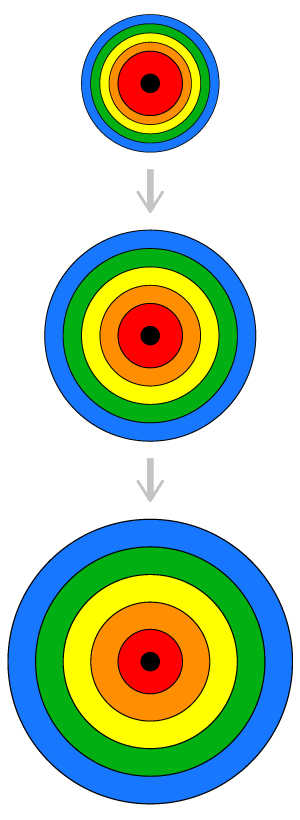
Color coded illustration of a functional bit shifting from a stable into an unstable state as more unhealthy data accumulates.
The life cycle of a bit
As you probably have realized, a bit of memory for your brain, is not the same as a bit for a computer.
The bits used for your memory, have a life cycle consisting of three stages; functional, dysfunctional and destructive.
Stage 1: Functional Bits
Functional bits are considered the only type of healthy bit.
This is because the bits have energy available for you to use the information.
These self-empowered bits are independent and make you feel like you can do anything.

A color coded illustration of a functional bit.
Stage 2: Dysfunctional Bits
A dysfunctional bit is considered permanently damaged.
Dysfunctional bits have a value of zero for available energy / brain power.
Although you can read the data, you cannot use the data without providing an external source of energy.
These disempowered bits require co-dependence on other people and chemical addictions to provide the necessary energy.

A color coded illustration of a dysfunctional bit.
Dysfunctional Data is purple.
Stage 3: Destructive Bits
A destructive bit is also considered permanently damaged.
Destructive bits have a negative value for energy / brain power.
This means they automatically reduce brain power produced by functional bits.
Destructive bits operate as a separate unit of consciousness that will automatically resist anything you want to do.
Destructive bits are the source of every mental health issue.

A color coded illustration of a destructive bit.
The internal environment of a functional bit.
Bits are pressurized
Bits have an internal pressure system that can dramatically influence your state of mind when focusing on them.
Healthy pressure from the core
The pressure from the functional data pushes outward from the core.
This outward pressure generates the feeling of being self empowered and believing that you can overcome the odds.
Unhealthy pressure from outside
The unhealthy data from external sources pushes inward towards the core.
As the quantity of unhealthy data increases, so does the pressure.
When the external pressure becomes too great, you start feeling overwhelmed.
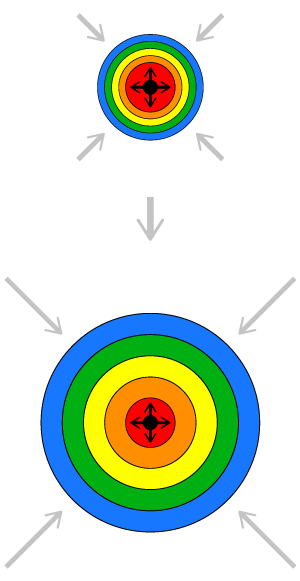
Color coded illustration of a stable functional bit and an unstable functional bit.
The arrows on the corners indicate the increase in pressure as unhealthy data accumulates.
Converting from a functional bit to a dysfunctional bit.
The collapse is emotional
Once the amount of external pressure exceeds the internal pressure from the core, the functional bit collapses.
When the collapse occurs, the energy associated with functional data releases as an emotional discharge.
During the collapse, the functional and unhealthy data fuse together, producing dysfunctional data.
This bit is now considered permanently damaged because it will never return to a functional state.
Dysfunctional data is shown as purple in the illustration.
Anxiety wrapped in a dysfunctional bit
You can look at the data in a dysfunctional bit, but you can’t use it.
It’s important to note that dysfunctional data is always distorted, which causes that cloudy sensation when you struggle to focus.
When you try to use the dysfunctional bit, you feel frustration and anxiety.
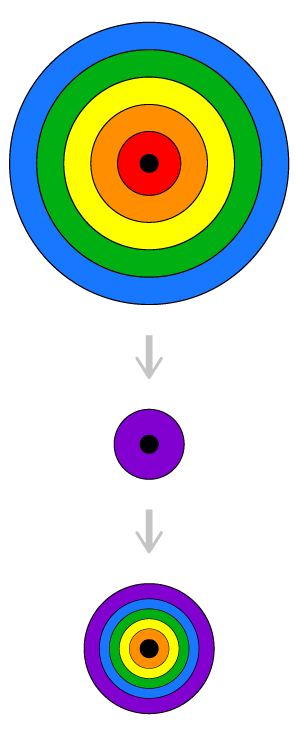
Color coded illustration of an unstable functional bit collapsing into a dysfunctional bit.
Insane Brain Damage
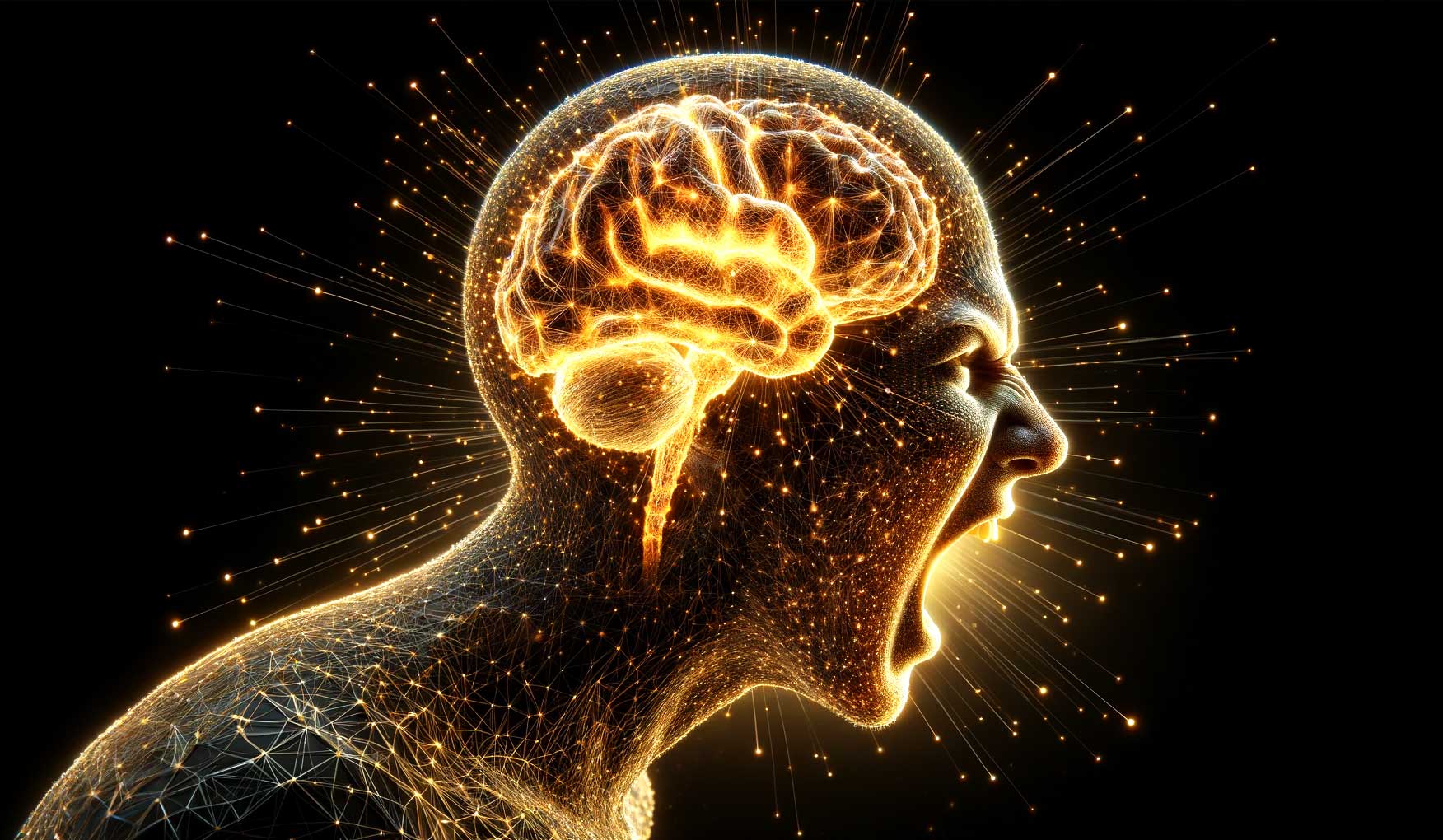
"Every emotional blowout you have experienced throughout your life, indicates permanent brain damage has occurred as a result of too much unhealthy data."
The evolution of a dysfunctional bit
It only gets worse from here
It is no longer possible to write healthy data into a dysfunctional bit.
However, every time you look at the dysfunctional bit, your brain will write additional unhealthy data into it.
Once a bit is dysfunctional, it is best to leave it alone.
The big question of course, is how do you do this?
Forcing the dysfunctional bit to function
When a person tries to force their brain to use dysfunctional bits, they require an external source of energy, such as caffeine, nootropics, micro-dosing or pharmaceuticals.
This is also the point when a person will hire a coach or therapist to try and fix the issue for why they can no longer function.
All of these approaches will cause additional unhealthy data to be written into the dysfunctional bits.
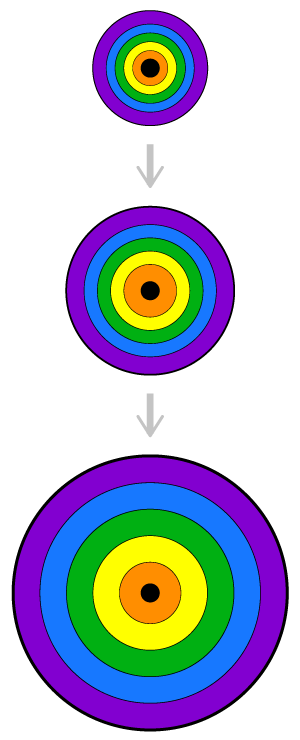
Color coded illustration of a dysfunctional bit converting from stable to unstable by increasing unhealthy data.
Escaping the Pressure
Dysfunctional data pulls outward
The internal pressure for a dysfunctional bit is not the same as the functional bit.
Dysfunctional data is located on the outside of the bit, while the unhealthy data is located on the inside.
The dysfunctional data’s pressure pulls outward on the bit.
When looking at the bit, this type of pressure creates the desire to escape, causing your brain to go into escape mode.
The escape intensifies
As additional unhealthy data is written inside the bit, the pressure focused inward increases.
The inwards pressure makes you feel like your life is going to collapse.
In order to keep the bit from collapsing, you need more energy pulling outwards.
This is usually done by ramping up your dose of stimulants such as caffeine, sugar & carbs.
When these are not enough, adderall, micro-dosing, pharmaceuticals, nutritional supplements and nootropics are often tried.
Eventually you reach the maximum pressure and the dysfunctional bit will collapse.
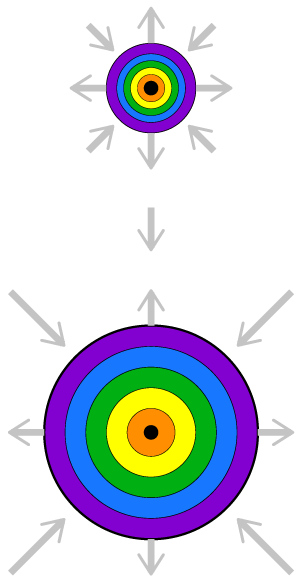
Color coded illustration of pressure of a stable and unstable dysfunctional bit.
From dysfunctional to destructive
The second collapse
You can only increase the amount of unhealthy data in a dysfunctional bit so much, until it collapses a second time.
As with the first collapse, the second collapse also releases a lot of energy.
The second collapse can involve a panic attack or possibly violent form of emotion.
After this collapse, the bit moves into its final destructive state.
The objective is pure chaos and destruction
The destructive bit is a separate unit of consciousness that is no longer under the control of your brain.
In order to be a separate unit of consciousness, the bit will automatically want the opposite of everything you want.
If you want left, it wants right. If you change your mind and want right, it will immediately want left.
The destructive bit can be classified as pure resistance to anything you want.
Destructive bits have a negative effect on brain power.
They want to grow...
Destructive bits cannot accumulate additional unhealthy data.
Instead, they merge together with other destructive bits, becoming more intelligent and even more destructive.
They try to influence your mind, to destroy your life and cause chaos, so you create more destructive bits.
They evolve...
Destructive bits initially express themselves as conflicting thoughts.
As they merge, their influence and power grows, becoming separate voices in your head that cause endless torment.
Destructive bits are the source of every major mental health disorder.
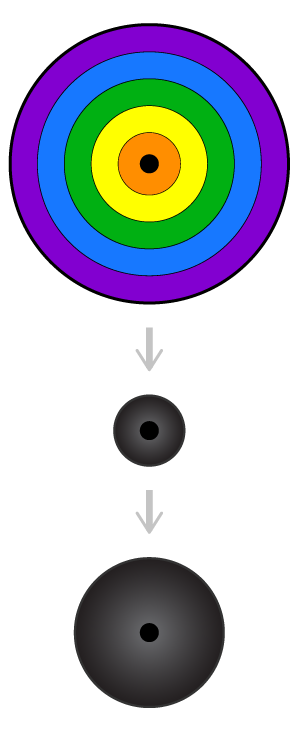
Color coded illustration of an unstable dysfunctional bit that collapsed into a destructive bit.
As destructive bits merge, they grow in size and influence.
You now understand the life cycle of a bit!
As you can see, there is a lot to understand about bits and how your brain uses them to store memory.
I hope as you read this section, you were able to gain a better understanding of the process you went through during the most difficult times in your life.
Tough to watch, even tougher to go through.
I personally become sad when I watch the life cycle of a bit play out in real life.
The most important people and things in our life, are the bits we focus on the most.
As a result of this focus, the unhealthy data accumulates faster, destroying the connection with whom and what we love.
The more I learned, the more I realized the game is rigged.
Since you understand the basics for the life cycle of a bit, you can see what I consider to be the biggest problem with how our brain processes data.
No matter what you initially love in life, it’s only a matter of time before the accumulation of unhealthy data separates you from it.
There is only one viable solution.
The software the human brain uses to process data, needs to be upgraded.
The only way this is possible, is using consciousness software.
Calculating the health of a data network
The health of a data network is determined by the total brain power available from all the bits within it.
The life cycle of a bit cannot be reversed. Once the bit becomes dysfunctional or destructive, it’s considered permanently damaged.
However, the health of a data network can be restored back to a healthy and functional state using iBots.
Increasing the brain power for a data network can be accomplished by permanently removing dysfunctional and destructive bits.
Brain power of a data network
The brain power of a data network can be measured by adding up the available energy from all of the individual bits.
There are two numbers that are important, potential and actual brain power.
Potential brain power is how much you would have in total if all of the bits were functional and had no unhealthy data.
Actual brain power is what’s left after the unhealthy data, dysfunctional and destructive bits have been factored in.
Destructive bits have a negative value, reducing the amount of brain power for the entire data network.
The numbers (not for non-technical people)
Let’s say that all of the functional bits have an average of 10 units of energy.
In total, there are 1,000 bits in the data network.
This means the potential brain power of the data network is 10,000 units of energy.
If 600 bits are functional (6,000 units), but have an average of 50% unhealthy data (-3,000 units), that would leave only 3,000 units of available energy.
If 300 bits are dysfunctional, we would have to subtract 3,000 units of potential energy, because dysfunctional bits are worth zero.
If 100 bits are destructive, they would be valued at -1,000 units of energy.
The result is 3,000 units of energy from productive bits with -1,000 units from the destructive bits, leaving the data network with only 2,000 actual units of energy.
The available brain power of this data network is only 20%.
A data network becomes dysfunctional at around 30% brain power.
The data network becomes destructive at 0% brain power, because it needs to merge with other data networks in order to function.
This is why a destructive data network loses the ability to maintain boundaries.
Revitalizing the health of your data networks
The life cycle of a bit cannot be reversed.
Once the bit becomes dysfunctional or destructive, it’s considered permanently damaged.
However, the health of a data network can be restored back to a healthy and functional state using iBots.
Removing Bits with iBots
Increasing the brain power for a data network can be accomplished by permanently removing dysfunctional and destructive bits.
iBots can permanently remove four types of bits that are reducing the brain power in every data network.
By removing these bits, the available brain power within the data network will increase, restoring it back to a functional state.
Super networks
Super networks are created for complex things that your life revolves around, like a relationship, job or the most complex super network, a business.
A super network is made up of one primary network and many sub-networks.
For instance, you can think of your home as the primary network.
All of the people living in your home, as well as the objects within your home are considered sub-networks.
Each activity you and your family members do in your house, are also a sub-network.
Primary networks
Primary data networks are important as they command a lot of power over your life.
Your primary networks define your values during each phase of your life.
As you age, your primary networks typically change.
For instance, when you are young, your parents and siblings are your primary networks.
When you are a teenager, your best friends and school are your primary networks.
When you are an adult, your career, spouse and children become your primary networks.
A sport, hobby or specialized skillset can also be considered a primary data network, based on how much you prioritize your life around it.
If you are an olympic athlete, then your sport has been your primary network for almost your entire life.
Using tiers to classify sub-networks
A primary data network is classified as tier 1. This would include your business or spouse.
Sub-networks are smaller data networks directly linked to one or more primary networks.
For instance, Your business (tier 1), will be associated with many different sub-networks (tier 2).
You will have tier 2 sub-networks for each division of your business, such as marketing, customer support, product development, HR, and for the executive team as a whole.
Then each tier 2 network will connect with even smaller tier 3 sub-networks for the individual people, processes, software, data, etc… that are involved.
This is the mechanism your brain uses to organize multiple data networks within a super network.
Primary and sub-network relationships
Sub-networks are used by your brain to establish relationships between your data.
The health of a primary network such as your job, is also influenced by every tier of sub-networks associated with it.
For instance, if you quit your job that you hated at your old company, then got a new job at a new company, your brain will create a new primary data network for the new job.
When you are in the new primary data network it feels great, it’s clean with all new functional bits.
However, if your position entails the same skills and responsibilities from your previous job, you aren’t going to be happy.
As soon as you use those same skills at your new job, the associated sub-networks will transfer over to your new primary network, negatively affecting the health of it.
Within a few months, the health of the new primary data network for your job can drop to dysfunctional or even destructive, depending on the health of the sub-networks.
Stress fractures
Unhealthy sub-networks cause stress fractures within your super network.
When too many sub-networks are active at once, the conflicting data within them causes emotional stress and pressure.
For CEO’s, their entire business is a massive super network that can contain hundreds or even thousands of sub-networks.
The more complex the business is, the faster unhealthy data is being written into your bits.
The compounding of unhealthy data is the reason why CEO’s struggle with burnout.
Burnout is the result of your primary and sub-networks descending into dysfunctional and destructive states that can no longer produce functional bits.
